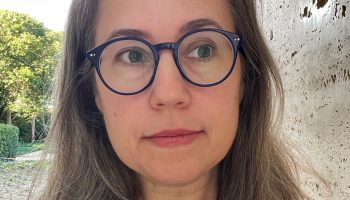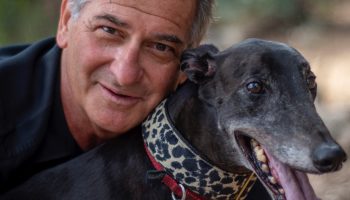Try to imagine what it may have been like for a master’s student in classical studies — one who has excavated Mediterranean archaeological sites in Israel, Greece and Sicily and is on the classical studies doctorate track — to come to grips with the fact that he not only knew, but also had taught introductory Latin to, a mass shooter.
Having fallen in with extremist ideology, this college student had used two pistols to wreak havoc during a Fourth of July weekend before taking his own life.
That wasn’t summer 2022’s mass shooting during the Independence Day parade in Highland Park, Illinois, home to one of the highest concentrations of Jewish residents in the Chicago region.
Rather, it was the three-day, racially motivated drive-by shooting in 1999 that took place in both Illinois and Indiana during which an Indiana University undergrad, who had grown up in Illinois, injured nine Orthodox Jews: men and boys on their way to their synagogue. He then killed an African American former Northwestern University basketball coach, and a Korean exchange student studying graduate level economics at Indiana University.
“That was my turning point,” Doyle Stevick said. “… This was just two months after Columbine. Within six months, my neighbor in Pittsburgh, just five blocks away, did the same thing.”
Stevick will give his talk, “Anne Frank and the Struggle for ‘Never Again,’ ” at 2 p.m. Saturday in the Hall of Philosophy. He will discuss the career path he pivoted to following his encounters with violent extremism in 1999.
This will be the final lecture in this season’s Contemporary Issues Forum speaker series sponsored by the Chautauqua Women’s Club.
Although Stevick completed his master’s in classical studies at Indiana University in 2001, he completed his doctoral work at Indiana University’s School of Education, earning his doctorate in history, philosophy and education policy studies, with a concentration in international and comparative education.
Stevick grew up in Pittsburgh and earned a Bachelor’s of Arts in mathematics, a second Bachelor’s of Arts in history and in classical studies, and a Master’s in ancient history at The Pennsylvania State University. Education policy and practice was a major academic shift.
“I was always bashing the Romans for their xenophobia,” Stevick said. “That had no impact on (that Latin student). It was like shampoo washing off in the shower. You can’t lecture people into (tolerance). I switched fields.”
From then on he devoted his career to understanding, combatting and most importantly, preventing divisive and threatening ideologies.
Stevick sought to “explore the power of education to undermine prejudice and foster prosocial dispositions.” He asked how schooling “could support positive institutional transformations, like Brown v. Board of Education or the collapse of the Soviet Union.”
And he challenged himself to identify the systemic cultural and social changes necessary for fulfilling “the promise of these profound changes,” and to figure out how schools might foster them.
Searching for answers led Stevick to investigations into “the re-emergence of civil society, democratic culture, and the rule of law in post-communist Europe, with a focus on Holocaust education.”
He was awarded fellowships that funded language and area studies in Romania and Estonia; research in Estonia and Taiwan; and travel expenses to be a visiting scholar at the Anne Frank House in Amsterdam. His last three books focus on Holocaust education.
Among the organizations with which Stevick has worked are the United Nations Educational, Scientific and Cultural Organization, the International Holocaust Remembrance Alliance and the Organization for Security and Cooperation’s Office for Democratic Institutions and Human Rights.
Currently, Stevick is an associate professor in the Department of Educational Leadership and Policies within the University of South Carolina’s College of Education, and the founder and former director of the college’s Office of International and Comparative Education.
He is also the founding executive director of the Anne Frank Center at the University of South Carolina. This university is the official U.S. partner of the Anne Frank House in Amsterdam. It hosts the only partner site in North America.
From July 6, 1942, until their discovery on Aug. 4, 1944, by German Nazis who occupied Amsterdam during WWII, Anne Frank — who had turned 13 on June 12, 1942 — hid with her 16-year-old sister and their parents as well as four others. Forced into confinement in a three-story secret annex at the back of the building where her German father, Otto Frank, had been the managing director of a pectin business, they were helped by six of his employees.
From the attic of the annex, Anne looked out at one of Amsterdam’s oldest horse chestnut trees. She wrote about the tree in her diary from this period, which was first published in the Netherlands in 1947.
Before the tree succumbed to disease and a strong windstorm in 2010, chestnuts from it were gathered and germinated, and the saplings generated were donated to schools and to other organizations and locations around the world, including special gardens, that were named after or affiliated with Anne.
Similar to how the chestnuts from this tree are spread, the Anne Frank Center’s website shares their mission to share Anne’s story:
“By sharing Anne’s legacy with visitors, students and teachers, UofSC’s Anne Frank Center seeks to inspire our commitment to never be bystanders but instead to stand up together against anti-Semitism, bigotry and inequality wherever it may exist today.”
Stevick feels as though conversation and connection are ways to overcome this hate.
“We have to learn that we can get along nicely,” Stevick said. “By getting to know one another we can actively build communities of upstanders.”
The Anne Frank Center for Mutual Respect (formerly known as the Anne Frank Center USA), which is based in New York City, has broadened its mission from speaking out against anti-Semitism to exposing and fighting hate more generally, including a broad array of civil and human rights challenges. Chautauquan George Fechter has been a member of its board of directors.
Stevick feels as though the Anne Frank House “stood out for its dynamic approach to cultivating pro-social attitudes and behaviors and undermining prejudice and hate.”
He said that knowledge about Anne Frank is global and that they have developed a traveling exhibition that has “swept the world … on a shoestring budget.” It has been featured in 89 countries.
“Talking with people instead of at them … was a brilliant move,” Stevick said. “From Anne Frank we learned that … children’s voices matter. She’s the only peer we learned from. We learn about Emmett Till, but not his words, just his smile. … With the traveling exhibition, children are learning with one another.”
The staff of the Anne Frank House in Amsterdam and its partner organizations have been training children to lead the exhibition and conversations, including at schools with dirt floors in South Africa.
“They (learn) they aren’t alone in their struggles,” Stevick said. “Their teachers are blown away. For the first time, children have a room full of adults hanging on their every word. The power of this got me involved.”
His professional pivot in response to the horrific violent extremism he encountered as a graduate student in classical studies has empowered Stevick to explore methods of countering anti-Semitism and prejudice through creative and inclusive education policies and practices.
On Saturday afternoon, he will have much more to share — including information about the pilot program that Buffalo, New York, is leading to bring together its public and private schools.




